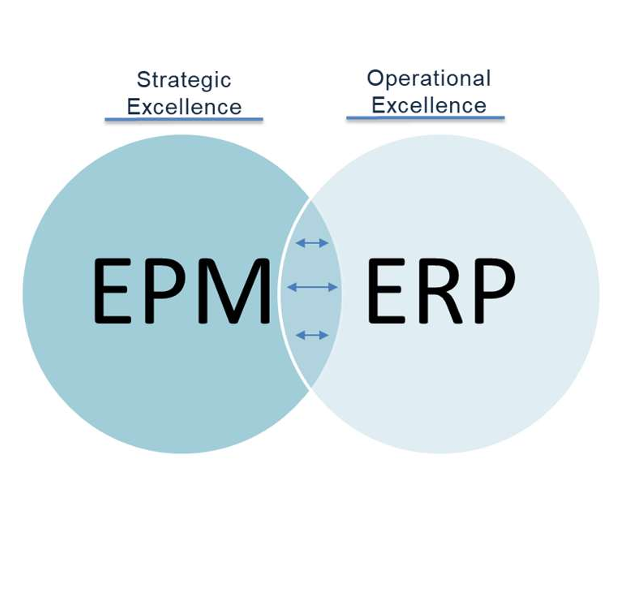EPM vs. ERP: Understanding the Two Pillars of Enterprise Management
Enterprise Performance Management (EPM) and Enterprise Resource Planning (ERP) systems are often misunderstood as interchangeable technologies. However, while they complement each other in managing and optimizing business operations, their functions, audiences, and strategic purposes are fundamentally different. As a boutique consulting firm specializing in enterprise solutions, we believe it is crucial for organizations to understand the distinction between these systems to ensure successful technology investments and improved organizational outcomes.
The modern enterprise operates in an increasingly complex environment, with demands for agility, accuracy, and accountability. To meet these demands, companies turn to digital systems like ERP and EPM. While ERP systems are designed to manage day-to-day operations, EPM systems focus on strategic planning, analysis, and performance optimization. Understanding the unique value of each system and how they work together is essential to building a robust enterprise architecture.

What Is EPM?
EPM systems are strategic and support the processes required to plan, monitor, and improve business performance. EPM encompasses budgeting, forecasting, financial consolidation, scenario modeling, and performance reporting. While ERP tells you what happened, EPM helps you decide what to do next. EPM systems are often used by finance teams, executive leadership, and business analysts to guide strategic decision-making.
What Is ERP?
ERP systems are the backbone of operational efficiency. They consolidate core business processes such as finance, supply chain, procurement, human resources, and manufacturing into a single integrated system. By enabling real-time data flow across departments, ERP systems ensure consistency, accuracy, and compliance. ERP systems are typically transactional in nature. They are optimized for recording activities, managing workflows, and automating routine processes.
Key Differences Between EPM and ERP
1. Purpose: ERP focuses on operational execution, while EPM supports strategic planning and decision-making.
2. Users: ERP systems are used by operational staff across departments; EPM systems are primarily used by finance and executive leadership.
3. Data Types: ERP manages transactional data (e.g., invoices, inventory levels); EPM manages analytical data (e.g., budgets, KPIs, forecasts).
4. Time Orientation: ERP looks at current and historical data; EPM is future-focused, supporting what-if analysis and scenario planning.
5. Implementation Cycles: ERP implementations tend to be longer and more complex; EPM implementations are typically more agile and iterative.
| Feature | EPM | ERP |
| Focus | Financial Analysis, Budgeting, & Forecasting | Transactions, Operations, Accounting |
| Who Uses it? | CFO, FP&A, Business Leaders | Supply Chain, HR, IT, Accounting |
| System Examples | Anaplan, Oracle EPM Cloud, OneStream | SAP, Oracle NetSuite, Microsoft Dynamics 365 |
| Purpose | Helps business make decisions | Helps business run operations |
Why the Distinction Matters Confusing EPM with ERP
Treating EPM as merely an ERP module can lead to underinvestment in strategic capabilities. Organizations that rely solely on ERP systems for planning and performance analysis often struggle with manual processes, limited flexibility, and siloed data. On the other hand, companies that implement both systems enjoy a more complete and agile enterprise architecture. ERP provides the transactional backbone, while EPM turns data into insights and action.
How EPM and ERP Work Together
ERP (Engine): Think of ERP as the engine of a car. It powers the vehicle, ensuring all components like fuel injection, transmission, and brakes work seamlessly. Similarly, ERP systems handle the day-to-day operations of a business, such as finance, HR, procurement, and supply chain management.
EPM (GPS): EPM, on the other hand, is like the car’s GPS. While the engine keeps the car moving, the GPS provides direction, helping you plan the best route, anticipate traffic, and adjust to road conditions. EPM systems guide strategic planning, budgeting, forecasting, and performance analysis, enabling businesses to navigate toward their goals effectively.
How Arete EPM helps clients navigate the EPM-ERP landscape by:
- Assessing current technology stacks and identifying gaps
- Defining clear roles for ERP and EPM within enterprise strategy
- Selecting and implementing the right EPM solutions
- Ensuring seamless integration between ERP and EPM systems
- Providing change management and training for effective adoption
Takeaway
ERP and EPM are two sides of the enterprise management coin, while both essential, but with distinct roles. Understanding the divide allows organizations to align technology with strategy, optimize performance, and build resilience in a dynamic business environment. By investing in both, companies can move from simply running their business to continuously improving it.












